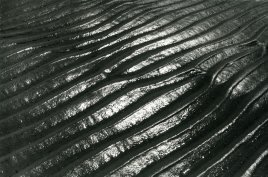Arvid Gutschow and Alfred Ehrhardt
dal 10/1/2013 al 16/3/2013
Segnalato da
10/1/2013
Arvid Gutschow and Alfred Ehrhardt
Alfred Ehrhardt Stiftung, Berlin
Two of a Kind. The exhibition juxtaposes the landscape photographs by Gutschow and Ehrhardt, both self-taught photographers, as a demonstration of their shared interest in the development and dissipation of structures and patterns.

On January 11, 2013 the Berlin Alfred Ehrhardt Foundation will inaugurate the exhibition
Arvid Gutschow and Alfred Ehrhardt – Two of a Kind.
The encounter between these two photographers in this exhibition takes place on the
occasion of an extensive donation to the foundation of photographs by Arvid Gutschow, an
important forerunner of the New Photography, whose vision and choice of motifs are closely
related to those of Alfred Ehrhardt. A part of the exhibition juxtaposes the landscape
photographs by Gutschow and Ehrhardt, both self-taught photographers, as a demonstration
of their shared interest in the development and dissipation of structures and patterns. In
addition, the exhibition demonstrates how Ehrhardt adapted and refined Gutschow’s
structure-based perspective and the stylistic tendencies of the New Photography. The
exhibition includes 60 photographs by Arvid Gutschow and 10 photographs by Alfred
Ehrhardt.
Up until now the photographs of Arvid Gutschow (October 2, 1900, Hamburg – May 14,
1984, Seebergen near Bremen) have only been known to a small circle of experts. As a
doctor of law, Gutschow was originally employed as an executive administrator in the city
government of Hamburg. His father, a passionate hobby photographer, introduced him to
photography, and Gutschow began to photograph the landscape surrounding Hamburg at an
early age.
He was particularly interested in structures and forms of nature, such as light reflections on
water surfaces or the patterns left by the wind on beaches and dunes. Gutschow was also
interested in factory complexes and industrial buildings as a new kind of photographic
subject matter.
In 1929 Arvid Gutschow was included in the seminal exhibition of the German Werkbund
FILM UND FOTO in Stuttgart, which also toured internationally. His photographs were
published in various magazines and newspapers in the 1920s and 1930s, including Der
Querschnitt, Atlantis, Koralle, Das Deutsche Lichtbild, and PHOTOGRAPHIE Arts et Métiers
Graphiques. It is remarkable that he was able to engage in active photographic journalism
and attain such a high level of photographic achievement while fully employed.
Arvid Gutschow became well known through his photographic book See Sand Sonne (Sea,
Sand, Sun), which appeared in 1930 with the Gebrüder Enoch publishing house in Hamburg.
Including 75 photographs of the sea, watt, sand, dunes, and coastal plants, this early
publication is among the stylistic forerunners of photographic books of abstracted landscape
photography; it was also considered particularly progressive in terms of its layout. The
photographic volume was a source of inspiration for further books on the ocean, sea, and
dune landscapes in the 1930s. The largely abstract images of sand and water formations by
Gutschow reflect his clearly ordered and structural eye for composition, which is also
characteristic of Ehrhardt’s photographs of sand formations taken between 1933 and 1936
in the watt near Cuxhaven and in the Curonian Spit. Gutschow’s images have a
compositional and formal stringency that is also carried through in his later landscape and
technical photographs; in 1956 the well known Hamburg photo historian Fritz Kempe
described his work as follows: “Gutschow...cultivates: the art of confining, abstracting, and
compressing. This is complemented by his brilliant technique....Out of the continuous vitality
of nature springs the strength for the conceptual exactitude of his photography.”
Arvid Gutschow (1900-1984) grew up in Hamburg-Blankenese. His father familiarized him
with the medium of photography at an early age. After graduating from high school,
Gutschow began to study law, and after completing his doctorate Gutschow entered state
service for the district of Hamburg, from which he chose to retire in 1948. He pursued
photography in his spare time, working at an exceptionally high niveau. Through the mid
1950s he continued to develop a body of photographic work. Following his early retirement
he dedicated himself intensively to agriculture, environmental issues, and the problems of
developing countries.
Alfred Ehrhardt (1901-1984) worked as an organist, choir director, composer, painter, and
art educator before becoming a photographer and documentary filmmaker. After a period of
time at the Bauhaus in Dessau in 1928/29 he directed the first foundation course for the
study of materials outside of the Bauhaus, at the State Art Academy of Hamburg. After
being fired from his teaching position by the National Socialists due to his modernist
approach to art, he turned to photography and film. He became interested in the
geographical formations of the watt, traveled to Iceland, photographed crystals, mussels,
and corals, and worked in micro photography. Architectural photography and photographs of
sculptures were additional emphases in his oeuvre.
With works on loan from: Museum Folkwang, Essen; The Ann and Jürgen Wilde
Collection, Zülpich; Hans Jürgen Sieker, Executor of the Arvid Gutschow Estate, Eisenach;
derda rare books / thomas derda berlin/hannover, private collection.
A monograph on the work of Arvid Gutschow is being published by Hatje Cantz on the
occasion of the exhibition.
Opening: Friday, January 11, 2013, 7:00 pm
artpress – Ute Weingarten
Elisabethkirchstr. 15, 10115 Berlin, Tel:+49-(0)30-21 96 18 43
Email: artpress@uteweingarten.de
Alfred Ehrhardt Stiftung
Auguststr. 75 l 10117 Berlin
Opening hours: Tues to Sun 11:00 am – 6:00 pm, Thurs 11:00 am – 9:00 pm



